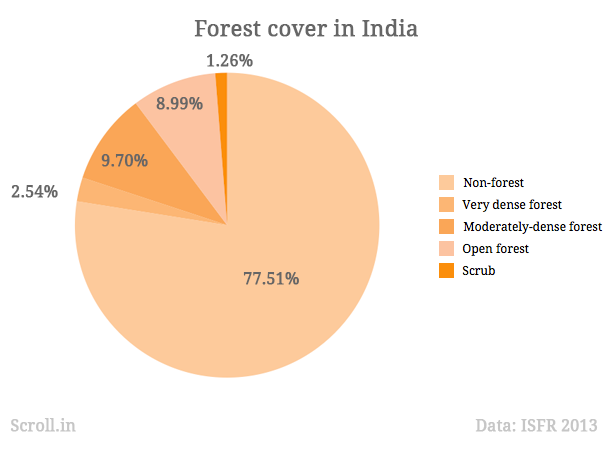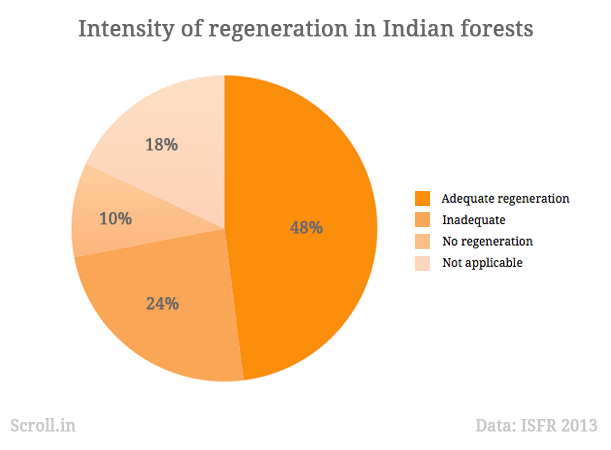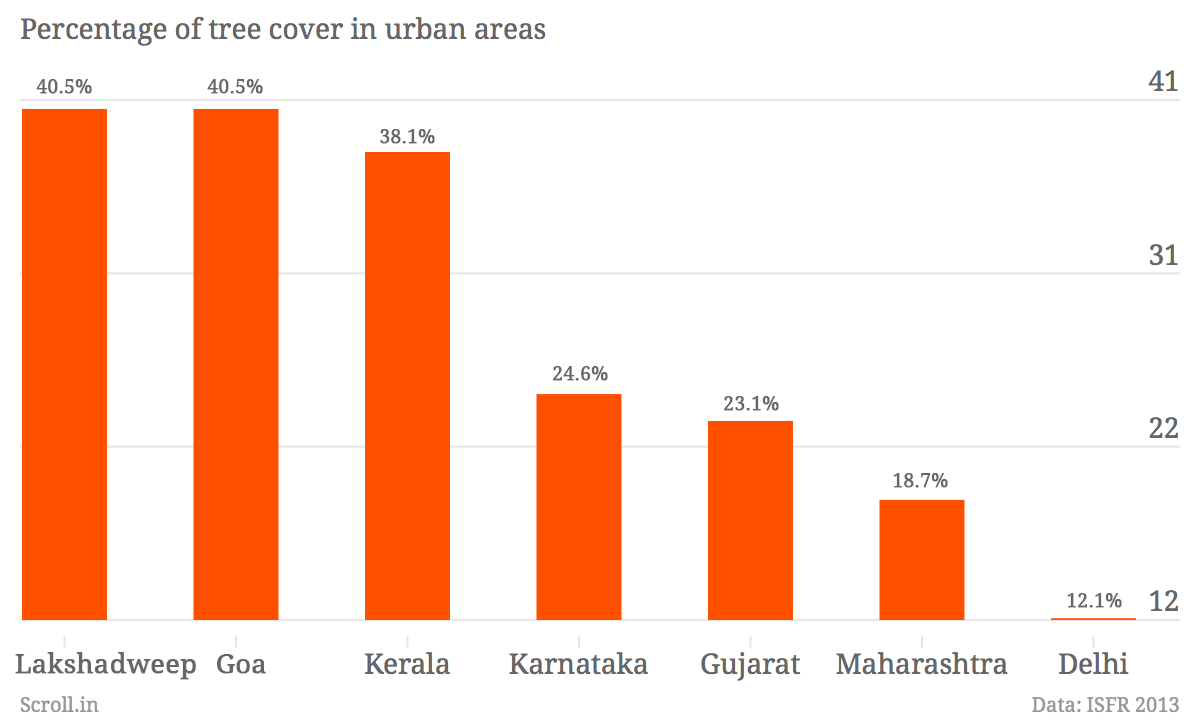Forest cover in India increased by 0.18% or 5,871 sq km in just over a year, between late 2010 and early 2012, claims a report released by the environment minister Prakash Javadekar, but that figure should actually be a cause for worry. In the same period, the northeastern region, one of the densest biodiversity hotspots in the country, recorded a loss of 627 sq km of forest area.
These findings were published in the India State of Forest Report 2013, a biennial report by the Forest Survey of India released on July 8. Although it is classified as the 2013 report, it is based on satellite remote sensing data collected between October 2010 and January 2012.
The report does not reflect very dramatic shifts in forest coverage since the previous survey report of 2011, and despite recording a technical increase in India’s forest cover, there is little else to cheer about.
Has forest cover really increased?
India has a total of 6.9 lakh sq km of forest cover and 91,266 sq km of non-forest tree cover, which accounts for 24% of the country’s geographical area. In all, 2.4% of India is covered with ‘very dense forests’, 9.7% with ‘moderately dense forests’ and 8.9% with ‘open forests’, the least dense of the lot.
Madhya Pradesh has the maximum forest cover of 77,522 sq km, followed by Arunachal Pradesh with 67,321 sq km and Chhattisgarh with 55,621 sq km. However, Arunachal Pradesh has the greatest amount of area with very dense forests (20,828 sq km), while nearly half of Madhya Pradesh’s forest cover is classified as open forest.
The 2013 report also claims that forest cover in India rose by 5,871 sq km, or 0.8%, but to say that would be fallacious.
In the 2011 report, the Forest Survey of India did not include 3,810 sq km of forest land in West Bengal, because of poor satellite data. The error has been corrected in the latest report, and accounts for more than two-thirds of the reported increase in national forest cover.
In addition, the report broadly defines forest area as any patch of land that is bigger than one hectare and that has a tree canopy density of more than 10%. “This could include several agricultural plantations that are not traditionally considered forests in the Survey of India maps,” said Kumar Sambhav Shrivastava, a forest and environment expert at the Centre for Science and Environment.
Unsurprisingly, a large portion (3.4%) of the rise in India’s forest cover, compared to the 2011 report, has been recorded outside of traditional forest areas, while just 0.02% of the increase is within traditional forests. “If green cover in general is increasing in India, it’s good, but natural forests are ecosystems in themselves and have a lot more biodiversity value,” said Shrivastava.
The northeast problem
Most of the decline in forest cover has been recorded in the eight north-eastern states, one of the most densely-forested regions in India. Here, the 2013 report records a 627 sq km decline in forests, 1.7% less than the area covered in 2011. Of the northeastern states, Nagaland recorded a 1.6% decline in forest cover, followed by Tripura (1%), Manipur (0.4%) and Mizoram (0.3%).
Given that this change occurred in just over about fifteen months, these are not small figures. “There is definitely a significant decline in forest cover in the northeast and it should be a matter of concern,” said Shrivastava.
While the report attributes most of the decline to shifting cultivation practices among the local populations, Shrivastava believes that claim needs further investigation. “Mining and other unregulated activities in the forests of the northeast could also be significant reasons for the decline in their forests,” he said.
Regeneration
If one considers the quality of forest cover that increased across India in the period covered, the report is not very optimistic. Compared to the 2011 figures, India gained only 31 sq km of very densely forested areas, and 7,831 sq km of open forests.
Meanwhile, the country lost a worrying 1,991 sq km of moderately dense forest land, indicating that the quality of these forests has been degrading and they are getting transformed into less dense, open forests.
According to the report, forests are declining mainly because of mining and development work, shifting cultivation and encroachment.
In order to maintain the density of forests, it is important for them to regenerate, either naturally or artificially. But according to the 2013 report, less than half of India’s forests have an adequate intensity of regeneration. In fact, 10% of forests are not regenerating at all.
Mangroves and urban tree cover
Mangroves occupy 4,628 sq km of India, half of which is in the Sunderbans in West Bengal. Mangrove cover has declined by 34 sq km compared to the 2011 report.
The urban tree cover across India is 12,790 sq km, which forms 16.4% of all urban areas in the country. Tamil Nadu has the maximum urban tree cover (1,509 sq km), although Lakshadweep and Goa have the highest proportion of urban tree cover (40.5% of its urban areas).
These findings were published in the India State of Forest Report 2013, a biennial report by the Forest Survey of India released on July 8. Although it is classified as the 2013 report, it is based on satellite remote sensing data collected between October 2010 and January 2012.
The report does not reflect very dramatic shifts in forest coverage since the previous survey report of 2011, and despite recording a technical increase in India’s forest cover, there is little else to cheer about.
Has forest cover really increased?
India has a total of 6.9 lakh sq km of forest cover and 91,266 sq km of non-forest tree cover, which accounts for 24% of the country’s geographical area. In all, 2.4% of India is covered with ‘very dense forests’, 9.7% with ‘moderately dense forests’ and 8.9% with ‘open forests’, the least dense of the lot.

Madhya Pradesh has the maximum forest cover of 77,522 sq km, followed by Arunachal Pradesh with 67,321 sq km and Chhattisgarh with 55,621 sq km. However, Arunachal Pradesh has the greatest amount of area with very dense forests (20,828 sq km), while nearly half of Madhya Pradesh’s forest cover is classified as open forest.
The 2013 report also claims that forest cover in India rose by 5,871 sq km, or 0.8%, but to say that would be fallacious.
In the 2011 report, the Forest Survey of India did not include 3,810 sq km of forest land in West Bengal, because of poor satellite data. The error has been corrected in the latest report, and accounts for more than two-thirds of the reported increase in national forest cover.
In addition, the report broadly defines forest area as any patch of land that is bigger than one hectare and that has a tree canopy density of more than 10%. “This could include several agricultural plantations that are not traditionally considered forests in the Survey of India maps,” said Kumar Sambhav Shrivastava, a forest and environment expert at the Centre for Science and Environment.
Unsurprisingly, a large portion (3.4%) of the rise in India’s forest cover, compared to the 2011 report, has been recorded outside of traditional forest areas, while just 0.02% of the increase is within traditional forests. “If green cover in general is increasing in India, it’s good, but natural forests are ecosystems in themselves and have a lot more biodiversity value,” said Shrivastava.
The northeast problem
Most of the decline in forest cover has been recorded in the eight north-eastern states, one of the most densely-forested regions in India. Here, the 2013 report records a 627 sq km decline in forests, 1.7% less than the area covered in 2011. Of the northeastern states, Nagaland recorded a 1.6% decline in forest cover, followed by Tripura (1%), Manipur (0.4%) and Mizoram (0.3%).
Given that this change occurred in just over about fifteen months, these are not small figures. “There is definitely a significant decline in forest cover in the northeast and it should be a matter of concern,” said Shrivastava.
While the report attributes most of the decline to shifting cultivation practices among the local populations, Shrivastava believes that claim needs further investigation. “Mining and other unregulated activities in the forests of the northeast could also be significant reasons for the decline in their forests,” he said.
Regeneration
If one considers the quality of forest cover that increased across India in the period covered, the report is not very optimistic. Compared to the 2011 figures, India gained only 31 sq km of very densely forested areas, and 7,831 sq km of open forests.
Meanwhile, the country lost a worrying 1,991 sq km of moderately dense forest land, indicating that the quality of these forests has been degrading and they are getting transformed into less dense, open forests.
According to the report, forests are declining mainly because of mining and development work, shifting cultivation and encroachment.
In order to maintain the density of forests, it is important for them to regenerate, either naturally or artificially. But according to the 2013 report, less than half of India’s forests have an adequate intensity of regeneration. In fact, 10% of forests are not regenerating at all.

Mangroves and urban tree cover
Mangroves occupy 4,628 sq km of India, half of which is in the Sunderbans in West Bengal. Mangrove cover has declined by 34 sq km compared to the 2011 report.
The urban tree cover across India is 12,790 sq km, which forms 16.4% of all urban areas in the country. Tamil Nadu has the maximum urban tree cover (1,509 sq km), although Lakshadweep and Goa have the highest proportion of urban tree cover (40.5% of its urban areas).

Limited-time offer: Big stories, small price. Keep independent media alive. Become a Scroll member today!
Our journalism is for everyone. But you can get special privileges by buying an annual Scroll Membership. Sign up today!